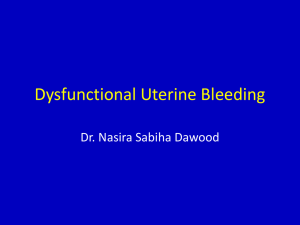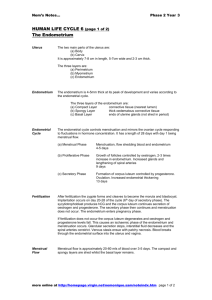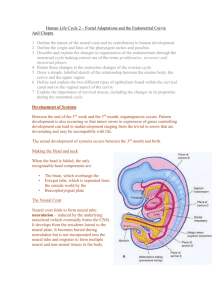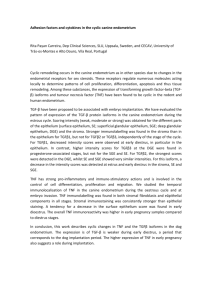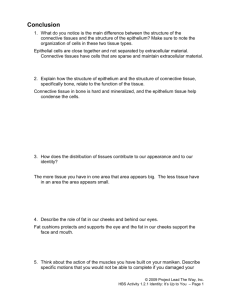Repro04-FemaleHisto2
advertisement
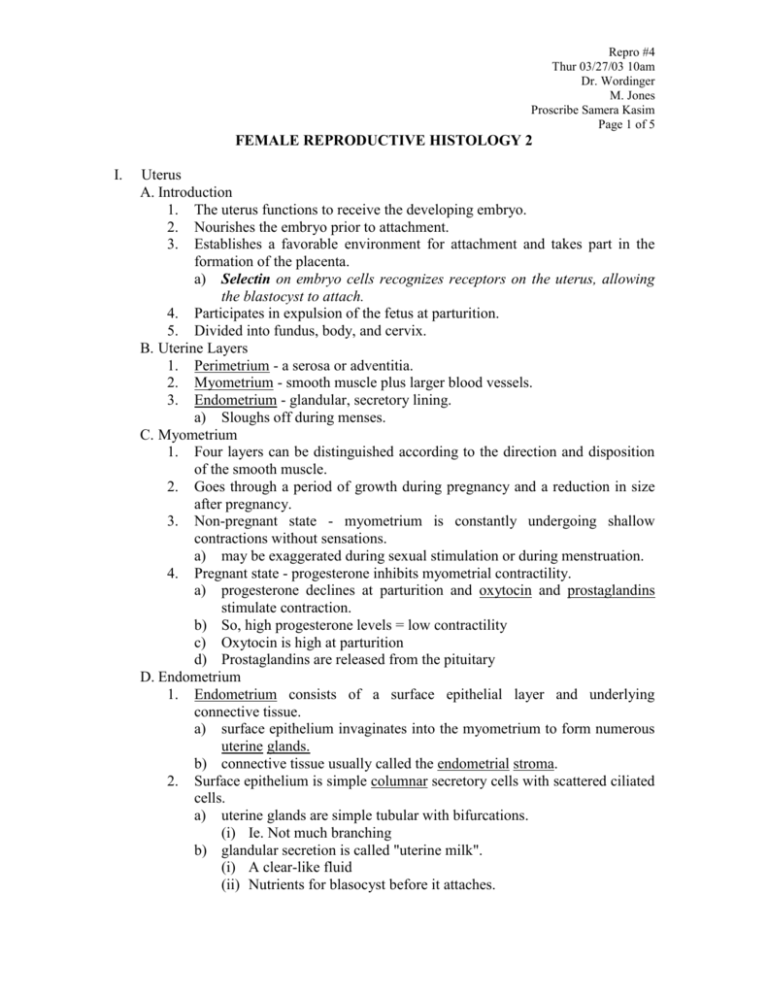
Repro #4 Thur 03/27/03 10am Dr. Wordinger M. Jones Proscribe Samera Kasim Page 1 of 5 FEMALE REPRODUCTIVE HISTOLOGY 2 I. Uterus A. Introduction 1. The uterus functions to receive the developing embryo. 2. Nourishes the embryo prior to attachment. 3. Establishes a favorable environment for attachment and takes part in the formation of the placenta. a) Selectin on embryo cells recognizes receptors on the uterus, allowing the blastocyst to attach. 4. Participates in expulsion of the fetus at parturition. 5. Divided into fundus, body, and cervix. B. Uterine Layers 1. Perimetrium - a serosa or adventitia. 2. Myometrium - smooth muscle plus larger blood vessels. 3. Endometrium - glandular, secretory lining. a) Sloughs off during menses. C. Myometrium 1. Four layers can be distinguished according to the direction and disposition of the smooth muscle. 2. Goes through a period of growth during pregnancy and a reduction in size after pregnancy. 3. Non-pregnant state - myometrium is constantly undergoing shallow contractions without sensations. a) may be exaggerated during sexual stimulation or during menstruation. 4. Pregnant state - progesterone inhibits myometrial contractility. a) progesterone declines at parturition and oxytocin and prostaglandins stimulate contraction. b) So, high progesterone levels = low contractility c) Oxytocin is high at parturition d) Prostaglandins are released from the pituitary D. Endometrium 1. Endometrium consists of a surface epithelial layer and underlying connective tissue. a) surface epithelium invaginates into the myometrium to form numerous uterine glands. b) connective tissue usually called the endometrial stroma. 2. Surface epithelium is simple columnar secretory cells with scattered ciliated cells. a) uterine glands are simple tubular with bifurcations. (i) Ie. Not much branching b) glandular secretion is called "uterine milk". (i) A clear-like fluid (ii) Nutrients for blasocyst before it attaches. Repro #4 Thur 03/27/03 10am Dr. Wordinger M. Jones Proscribe Samera Kasim Page 2 of 5 3. Endometrial stromal tissue resembles mesenchyme with irregularly stellate cells with large, ovoid nuclei. a) Mesenchyme is undifferentiated connective tissue b) Embryonic in appearance probably because it breaks downs and rebuilds so often. 4. Endometrium is under the hormonal control of the ovary. E. Menstrual Cycle 1. Introduction a) the ovarian hormones (estrogens and progesterone) cause the endometrium to undergo cyclic, structural changes. (i) They control the morphology and physiology of the endometrium (ii) Ex: 17-B estradiol b) cycles begin at puberty (12-15 years) and continue until menopause (45-50 years). c) various phases of the menstrual cycle: proliferative, secretory and menstrual. 2. Proliferative Phase a) preceded by the menstrual phase and occurs between days 5-14. b) takes place during ovarian follicular development. c) basal (basalis) layer of the endometrium remains following menstruation and proliferates. Uterine gland cells proliferate, migrate to the surface and reconstitute the epithelium. d) glands are straight and narrow at end of the phase. e) coiled arteries are elongated and convoluted. (i) Aka Spiral arteries f) Estradiol secreted from the follicle is prominent and endometrial regrowth is occurring. 3. Secretory or Luteal Phase a) begins at ovulation and is dependent upon progesterone produced by the corpus luteum. b) There are high levels of progesterone, low estradiol levels c) lasts from the 15th to the 28th day of the cycle. d) uterine glands become tortuous, dilate and secrete uterine milk. e) Endometrium reaches its maximum thickness. f) elongation and convolution of the coiled arteries continue and extend into the superficial portion of the endometrium. g) progesterone stimulates the glands to secrete glycoproteins that will be the major source of embryonic nutrition before implantation occurs. 4. Premenstral Phase a) Often not a phase addressed by textbooks. b) More a histological phase than physiological; can be detected histologically, but is not necessarily able to be noticed physiologically. c) Contraction of the arteries, leading to ischemic regions in the functionalis is indicative of the pre menstral phase. Repro #4 Thur 03/27/03 10am Dr. Wordinger M. Jones Proscribe Samera Kasim Page 3 of 5 5. d) The entire endometrial layer is still present; any shedding of the layer would indicate entry to the menstral phase Menstrual Phase a) Don’t confuse this with “menstral cycle.” The Cycle is 28 days, while the phase is 1-4 days within the cycle. b) beginning of menstrual blood signals the beginning of the menstrual cycle. c) this phase lasts 1-4 days. d) at the end of the secretory phase the walls of the coiled arteries contract thus causing ischemia and necrosis of the endothelium. (i) Again, this could be considered the premenstrual phase as long as the entire endometrial layer is present. e) occurs when implantation fails and estrogen and progesterone levels fall. f) desquamation of the endometrium and rupture of blood vessels takes place. g) by the end of this phase only the basal layer of the endometrium remains. h) proliferative phase then gradually restores the endometrium. II. Cervix A. Introduction 1. Narrow segment of the uterus and major area of adenocarcinoma. a) Usually found in the transition area between the uterus and cervix b) Determined by pap smear with will show nuclei that are much larger than normal c) Normal nuclei are VERY tiny, seen as a tiny dot. d) Cancerous cells may have nuclei that are ½ the size of the cell e) Some smears may show early signs of cancer and should be watched very closely with yearly exams f) At times, the “pre cancerous” cells don’t become cancerous for 20 years (+) 2. Wall of the cervix is continuous with uterus but is not primarily smooth muscle, thus doesn’t contract. a) B. Histology 1. Mucous membrane is folded and consists of epithelium (simple columnar epithelium) and connective tissue lamina propria. 2. Numerous large branch tubular glands present which consist of tall mucus secreting columnar cells. 3. External aspect of cervix bulges into lumen of vagina and is covered by stratified squamous epithelium. C. Histophysiology 1. Cervix dilates at parturition to accommodate fetus. Repro #4 Thur 03/27/03 10am Dr. Wordinger M. Jones Proscribe Samera Kasim Page 4 of 5 2. 3. Smooth muscle is not a major component of the cervical wall nor are elastic fibers. Relaxin "softens" the cervix by increasing blood supply and tissue fluid content. a) Relaxin brings water into the Connective tissue stroma to “soften” the cervix III. Vagina A. Introduction 1. Consists of mucosa, muscular layer and adventitia. a) a prolapsed uterus can become keratinized b) any mucus covered surface can become keratinized when exposed to the outside environment 2. Extends from the cervix to the vestibule. B. Histology 1. Mucosa consists of stratified squamous epithelium and a lamina propria. a) normally no keratinization occurs; glycogen is present in the cells. b) no glands are present. (i) The fluid present in the vagina is from the cervix c) acidity of vagina due to fermenting activity of bacteria on glycogen released into the lumen when cells desquamate. 2. Muscular layer consists of smooth muscle oriented in interlacing bundles. a) some are arranged circularly while other are longitudinal. 3. Adventitia consists of dense connective tissue containing an extensive venous plexus, sensory receptors and nerve fibers. 4. Lamina Propria and adventitia are rich in elastic fibers. Repro #4 Thur 03/27/03 10am Dr. Wordinger M. Jones Proscribe Samera Kasim Page 5 of 5 IV. Mammary Gland A. Introduction 1. Modified sweat glands (e.g. cutaneous) which produce an exocrine secretion by the apocrine mechanism. a) Consists of the budding of the cell surface which break off and produce a free floating secretory gland 2. Compound tubuloalveolar gland with irregular lobes. a) each lobe is separated by dense connective tissue and much adipose tissue. b) each lobe has a lactiferous duct which emerges in the mammary papilla (nipple). B. Inactive Mammary Gland 1. Intralobular connective tissue is dense and abundant and contains varying amounts of adipose tissue. 2. Ductal elements lined by epithelial cells are present. 3. Alveoli are small and not numerous. 4. secretory units are present but are not active C. Lactating Mammary Gland. 1. Soon after parturition, the mammary gland begins active secretion of milk rich in fat, sugar and proteins. a) Colosturm – first milk production 2. Alveoli become dilated with milk and have a low epithelium. 3. Estrogens and progesterone cause growth of the duct system at puberty. 4. Pregnancy - continuous and prolonged secretion of these hormones and placental lactogen and adrenal corticoids. 5. Oxytocin release from the pars nervosa stimulates myoepithelial cell contraction and promotes "milk let-down". 6. Plasma cells in the connective tissue surrounding the alveoli secrete IgA into the milk, providing the newborn with passive immunity.
